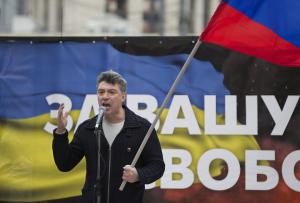MOSCOW (AP) — A few hours after going on the radio to denounce President Vladimir Putin's policies as mad, charismatic opposition leader Boris Nemtsov was gunned down early Saturday as he walked near the Kremlin.
Colleagues in Russia's beleaguered and marginalized opposition pointed fingers at the state or at assailants fired up by fervent nationalist sentiment in state-controlled news media. But Putin and other Russian politicians suggested the brazen attack was a provocation against the state.
Nemtsov, 55, was shot while walking with a female companion on a bridge over the Moscow River about 400 meters (yards) from the Kremlin. Russia's Investigative Committee said at least seven shots were fired.
Nemtsov was to have been a prominent participant in a march planned for Sunday in a Moscow to protest Russia's policies in Ukraine, where the West alleges the Kremlin has provided troops and equipment to separatist rebels, and the economic crisis sparked by Western sanctions over Ukraine and the plunge in oil prices.
Organizers canceled the march and said they would seek permission to hold a mourning rally for Nemtsov on Sunday. City authorities had made no decision on that by midday.
Through the morning, hundreds of people came to the site of Nemtsov's death to lay flowers.
View gallery

Boris Nemtsov, a former Russian deputy prime minister and opposition leader addresses demonstrators …
Nemtsov was working on a report presenting evidence that he believed proved Russia's direct involvement in the separatist rebellion that has raged in eastern Ukraine since April. Moscow denies backing the rebels with troops and sophisticated weapons.
Putin ordered Russia's top law enforcement chiefs to personally oversee the investigation of Nemtsov's killing.
"Putin noted that this cruel murder has all the makings of a contract hit and is extremely provocative," presidential spokesman Dmitry Peskov said in remarks carried by Russian news agencies.
U.S. Secretary of State John Kerry said Nemtsov committed his life to a more democratic Russia, "and to strong relationships between Russia and its neighbors and partners, including the United States."
German Chancellor Angela Merkel praised Nemtsov's courage in criticizing Kremlin policies, and urged Putin to insure that the killers are brought to justice, her spokesman Steffen Seibert said.
View gallery

In this file photo taken on Thursday, May 30, 2013, Boris Nemtsov, a former Russian deputy prime min …
Former Soviet leader Mikhail Gorbachev echoed the suggestion that the killing was a provocation. "It's an attempt to push the situation into complications, maybe even to destabilizing the situation in the country," he was quoted as saying by the Interfax news agency.
Communist Party leader Gennady Zyuganov agreed. "It's a provocation; for big fires, sacrificial figures are necessary," Interfax quoted him as saying.
Nemtsov frequently assailed the government's inefficiency, rampant corruption and Ukraine policy.
In an interview with the Sobesednik newspaper, Nemtsov said earlier this month that his 86-year old mother was afraid that Putin could have him killed. Asked if he had such fears himself, he responded: "If I were afraid I wouldn't have led an opposition party."
Speaking on radio just a few hours before his death, he accused Putin of plunging Russia into crisis by his "mad, aggressive and deadly policy of war against Ukraine."
View gallery

Russian police investigate the the body of Boris Nemtsov, a former Russian deputy prime minister and …
Nemtsov's lawyer, Vadim Prokhorov, said the politician had received threats on social networks and told police about them, but authorities took no steps to protect him.
Interior Ministry spokeswoman Yelena Alexeyeva told reporters that Nemtsov was walking with a female acquaintance, a Ukrainian citizen, when a vehicle drove up and unidentified people shot him. The woman wasn't hurt and was being questioned by police.
Kasyanov, the former prime minister, said he was shocked.
"In the 21st century, a leader of the opposition is being demonstratively shot just outside the walls of the Kremlin!" Kasyanov told reporters as Nemtsov's body, placed in a plastic bag, was removed on a rainy and cold night, as the Kremlin bells chimed nearby. "The country is rolling into the abyss."
"This is a monstrous tragedy and a loss for us all," Alexei Navalny, Russia's most prominent opposition figure, said on his Facebook page. He is currently on a 15-day jail sentence for handing out leaflets without authorization.
Garry Kasparov, a former chess champion who worked with Nemtsov to organize protests against Putin and now lives in the United States, said the killing shows that Putin and those who support him are lying when they say their popular support is strong.
"If you have 86 percent support, why do you kill someone like Boris?" he said.
Opposition activist Ilya Yashin, who last spoke to Nemtsov two days before the killing, said he had no doubt that Nemtsov's murder was politically motivated.
"Boris Nemtsov was a stark opposition leader who criticized the most important state officials in our country, including President Vladimir Putin. As we have seen, such criticism in Russia is dangerous for one's life," Yashin said.
Nemtsov served as a regional governor and then a deputy prime minister in the 1990s and once was seen as a possible successor to Boris Yeltsin, Russia's first elected president. After Putin came to power in 2000, Nemtsov became one of his most vocal critics.
Nemtsov was widely liked for his good humor, larger-than-life character and quick wit, but he and other top opposition figures long have been purged from state television and steadily marginalized by the Kremlin.
___
Associated Press writers Vladimir Isachenkov and Laura Mills in Moscow and Jake Pearson in New York contributed to this report.